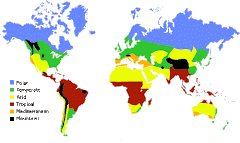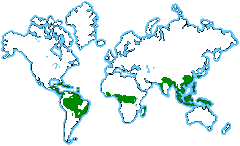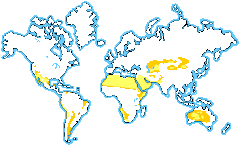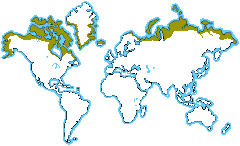WORLD BIOMES

lunes, 10 de marzo de 2008
Conclusion!
The biomes are a large geographical area of distinctive plant and animal groups, which are adapted to that particular environment. The climate and geography of abiome depends on their location. Each biome's organisms have different characteristics because they have to adapt to the way the biome is!
domingo, 9 de marzo de 2008
miércoles, 5 de marzo de 2008
What is a biome?
A biome is a large geographical area characterized by certain types of plants, animals, and weather (complex interactions of plants and animals with the climate)
The relationship between humans and the biomes is that the human need the biome to survive, because each biome contains the habitat for each person, for example, the beach, the city, the snow, etc.
lunes, 3 de marzo de 2008
Rainforest
Rain forest is made up of tall trees in a region of year-round warmth. A lot of rain falls every year (125 to 660 cm.). It has a brief season of less rain. Rain forests belong to the tropical wet climate group. Its temperature gets higher than 93 °F (34 °C) or drops below 68 °F (20 °C). Almost all rain forests lie near the equator. This biome produces the 40% of the Earth's oxygen.
A tropical rain forest has more kinds of trees than any other area in the world.
Desert
Deserts are the world's driest and hottest regions. Most of the vegetation there takes the form of drought-resistant plants such as cacti (cactus), which store water in their stems and have waxy coverings, The animals that live in the desert are able to survive with little or no water, for example the camel that stores water and fat in its hump, or the animals that can survive under ground, because they are not able to live in the heat of the sun, they only come out in the night when it is a little cooler.
A cold desert is a desert that has snow in the winter instead of just dropping a few degrees in temperature like they would in a Hot and Dry Desert. It never gets warm enough for plants to grow maybe just a few grasses and mosses. The animals in Cold Deserts also have to burrow but in this case to keep warm, not cool. (That is why you might find some of the same animals here as you would in the Hot and Dry Deserts)
.
Deserts cover about one fifth of the Earth's land surface. Most Hot and Dry Deserts are near the Tropic of Cancer or the Tropic of Capricorn. Cold Deserts are near the Arctic part of the world.
A cold desert is a desert that has snow in the winter instead of just dropping a few degrees in temperature like they would in a Hot and Dry Desert. It never gets warm enough for plants to grow maybe just a few grasses and mosses. The animals in Cold Deserts also have to burrow but in this case to keep warm, not cool. (That is why you might find some of the same animals here as you would in the Hot and Dry Deserts)
.
Deserts cover about one fifth of the Earth's land surface. Most Hot and Dry Deserts are near the Tropic of Cancer or the Tropic of Capricorn. Cold Deserts are near the Arctic part of the world.
Marine biome
The marine biome covers three fourths of the earth. The main kinds of animals in the sea are whales, dolphins, sharks, and seals which are some of the most popular kinds of sea mammals. Other kinds of animals and fish that live in the sea are the walrus, star fish, eel, crabs, jelly fish, and fresh and salt water fish, but this is just a small list compared to the many different kinds of fish that inhabit the marine biome. In general these fish have about five different adaptations. These adaptations include sleek bodies to cut down on friction when swimming through the water, gills to allow them to breath underwater, eyes on the sides of their heads so they can see enemies coming, fins to help them swim faster, and they have color coded skin to help them hide from their enemies. Most of the small fish are herbivores and the larger ones are carnivores.
The climate doesn't really effect it much. It is warmer as you get closer to the equator and it is colder as you get closer to the poles. Even though the climate doesn't effect the marine biome, the marine effects the mainlands climate a lot.
The climate doesn't really effect it much. It is warmer as you get closer to the equator and it is colder as you get closer to the poles. Even though the climate doesn't effect the marine biome, the marine effects the mainlands climate a lot.
Tundra
Arctic tundra
The arctic tundra occupies earth's Northern hemisphere, circling the North Pole all the way down to the evergreen forests of the boreal biomes. The soil of the arctic tundra is poor in nutrients, which accounts for the low amount of vegetation.
Alpine tundra
The alpine tundra biome exists on rocky mountaintops and is very similar to the arctic tundra except for a conspicuous lack of trees. Because trees cannot grow at this high altitude, most of the alpine tundra plant life consists of shrubbery and small leafy plants such as alpine bluegrass which serve as dinner to a variety of grazing animals such as bighorn sheep and mountain goats. Other alpine tundra animals include elk, pika, marmots, and birds such as the white-tailed parmigan and the grouse, and a few insects like grasshoppers, bumblebees, and beetles.
The arctic tundra occupies earth's Northern hemisphere, circling the North Pole all the way down to the evergreen forests of the boreal biomes. The soil of the arctic tundra is poor in nutrients, which accounts for the low amount of vegetation.
Alpine tundra
The alpine tundra biome exists on rocky mountaintops and is very similar to the arctic tundra except for a conspicuous lack of trees. Because trees cannot grow at this high altitude, most of the alpine tundra plant life consists of shrubbery and small leafy plants such as alpine bluegrass which serve as dinner to a variety of grazing animals such as bighorn sheep and mountain goats. Other alpine tundra animals include elk, pika, marmots, and birds such as the white-tailed parmigan and the grouse, and a few insects like grasshoppers, bumblebees, and beetles.
Suscribirse a:
Entradas (Atom)
created by
gaby!®








